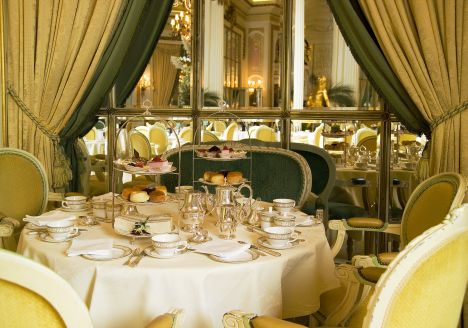
A history of the English tradition and hotels in London where it is celebrated at its best
The English tradition of afternoon tea is celebrated at its best in some of London’s famous five-star hotels. The exquisite and exclusive experience is very popular and therefore not cheap. Luckily, an afternoon tea is as much a hunger killer as an opulent lunch or dinner. It is an experience you should not miss. Make sure you reserve your table in advance.
All four hotels tested in January 2004, Brown’s Hotel, Claridge’s, Mandarin Oriental Hyde Park and The Ritz London offered an afternoon tea to a very high standard. The differences between them in quality were minor. The element that set them apart was the ambience and the style of the place in which afternoon tea is served.
Brown’s Hotel convinced with its unique old fashioned ambiance and charm created by comfortable sofas and chairs. It would not surprise me if the word “cosy” was invented there. The informal atmosphere reminded me of an old English country house. My friend Silvia, who accompanied me, elected it her favorite place for an afternoon tea and called it “funky” – others would say a bit worn down. Not surprisingly, Brown’s Hotel is closed for refurbishment until March 2005; they will try to do it softly, preserving the hotel’s charm. [added on April 14, 2012: I have stayed again at the Rocco Forte property in 2008 and 2012, which has been beautifully restored. In early 2012, they are using Jing teas at Brown’s Hotel].
At Mandarin Oriental Hyde Park, afternoon tea is served in The Park restaurant. All tables enjoy views onto Hyde Park. As in all four hotels, the traditional afternoon tea is accompanied by assorted finger sandwiches, freshly bakes scones and a choice of home-made cakes and pastries. In addition, Mandarin Oriental Hyde Park offers tea breads with preserves. A specialty of the house is the delicious rose petal jam. As in the other hotels, afternoon tea can also be ordered with champagne. The real originality at Mandarin Oriental Hyde Park is the shape of the finger sandwiches. Unlike the three other hotels, they are not traditionally made of two slices of bread, but only of one folded slice with a filling.
As for the atmosphere, The Park was the only modern afternoon tea venue tested. If you are looking for excellence in a contemporary style, Mandarin Oriental Hyde Park is your place. If you like the service but prefer a more traditional surrounding, do what I did, enjoy the afternoon tea in the elegant and classical English style of your hotel room. I remember that Nadja, the guest who joined me, was impressed by both the room and the afternoon tea.
At Claridge’s, afternoon tea is served in The Reading Room on the ground floor, next to The Foyer and the Front Hall. It was designed in 1898 when, in accordance with the move towards public dining, Claridge’s was redesigned to include several public rooms to accommodate guests. The Reading Room was built on the American model by the most celebrated interior designer of his day, Ernest George. Along with the foyer, it was refurbished in 1994 under the direction of Prue Lane Fox, respecting the art deco designs and lines of Oswald Milne, the foremost art deco designer of the 1930’s, with the centerpiece of The Reading Room remaining an oil painting of the founding hotelier, Marianne Claridge. In short, it is a place where the tradition of the English afternoon tea is celebrated in art deco elegance and style.
The specialty of Claridge’s is the fourteen different blends of tea, imported by the Paris specialist tea supplier Mariage Frères, France’s oldest importer of tea, established in 1854. In my view, Claridge’s offered the best and most unique vegetarian sandwiches. By the way, it was no problem at all to order excellent vegetarian sandwiches in all four hotels.
If you prefer glitz and glamour, The Ritz London must be your choice. Afternoon tea regulars through the years at The Ritz included Kind Edward VII, Charles Chaplin, Sir Winston Churchill, General De Gaulle, Noel Coward and Judy Garland. It is served in The Palm Court, built by Mewès and Davis and originally called Winter Garden. This was a standard feature of grand hotels around 1900. It was designed to fill the view of everyone who came through the Piccadilly entrance, which is closed today; guests now use the side entrance. The Palm Court is like a stage – and some waiters still know how to perform; I vividly remember one with an extraordinary dark voice. Afternoon tea at The Ritz is more than just tea, it is a performance.
Both at The Ritz and at Brown’s Hotel, finger sandwiches, scones and pastries are presented on a dramatic three-tier stand. At The Ritz, home made strawberry jam, clotted Cornish cream and fresh cream cakes accompany the sandwiches, scones and pastries. Different types of bread are used for each sandwich. There is also a choice of seven varieties of tea. In my opinion, The Ritz offered the best pastries, although differences between hotels were minimal.
The Tea Council elected The Ritz “Top London Afternoon Tea Award Winner” in 2004 (AA Britain’s Best: Afternoon Tea. 2004, p. 11). Please be aware of the six-week waiting list for the afternoon tea at The Ritz, unless you are a hotel guest. And mind the strict dress code, jacket and tie for men.
Service, presentation, pastries, scones, sandwiches and tea were excellent at all four hotels tested. They all must be highly recommended, not only for the afternoon tea, but also as places to stay overnight.
The history of the Afternoon Tea
According to a Chinese legend tea drinking began more than 5000 years ago. The Emperor Shen Nung decreed that, for reasons of hygiene, all drinking water should be boiled. One day when the court was having a rest during a journey, dried leaves from a bush fell into the pot – tea-drinking was born and spread quickly throughout China. As early as 800 AD, the first book about tea was written by a man called Lu Yu.
Zen Buddhist priests carried the tradition to imperial Japan. Tea first arrived in Europe in 1610. Due to its horrendous cost, it was a luxury item at first. With its growing popularity, prices fell. Tea came to Russia in 1618, as a gift from the Emperor of China to the Tsar.
Britain was the last of the great seafaring nations to join the Chinese and East Indian trade. The ships of the East India Company reached China in 1637, but it was not until 1644 that the British entered the tea trade. Sailors returning from the Far East introduced tea to London coffee houses. By 1700 one counted over 500 houses serving tea in the capital.
King Charles II who grew up in exile in France and Holland returned to England in 1660 to re-establish the monarchy. Two years later, he married the Portuguese Infanta Catarina de Braganza. Both were confirmed tea drinkers. The couple established tea drinking as as social and family ritual in Britain.
In 1773, American colonists protested against high taxes levied on tea. The so-called Boston tea party triggered the American colonies’ fight for independence. Had the tea drinking habit not spread to America during the 18th century, the USA might never have been established.
In Britain in good families, tea was served at the end of an evening’s entertainment, before the ladies went to bed. In the 1730’s, London’s pleasure gardens began serving tea. The idea quickly spread all over Britain.
The tradition of afternoon tea is credited to Anna, 7th Duchess of Bedford. In the early 1800’s, the Duchess apparently grew hungry between an early lunch and a late dinner and conceived the idea of a separate meal, served in her boudoir in the mid-afternoon, to ward off her own and her guests’ hunger pangs. This habit quickly spread in polite society.
However, tea only became available to the working class in the mid to late 19th century, when clipper ships speeded up transportation and large quantities of cheaper tea grown in India and Ceylon was imported. Apart from tap water, some 40% of all drinks served in Britain today are tea.
The “high tea” of ordinary people was quite different from the afternoon tea of high society. For the poor, who could not afford a proper cooked meal, it was the main meal of the day, comprising bread, meats, cakes or pastries, served with a good strong cuppa.
Britain’s first tea shop was established in 1864 by the manageress of the Aerated Bread Company, when the company directors permitted her to serve refreshment to favorite customers. Demand for the service grew quickly and spread across the country. It helped to liberate women since it was considered perfectly proper for a woman to meet friends in a tea shop without the imposition of a chaperone.
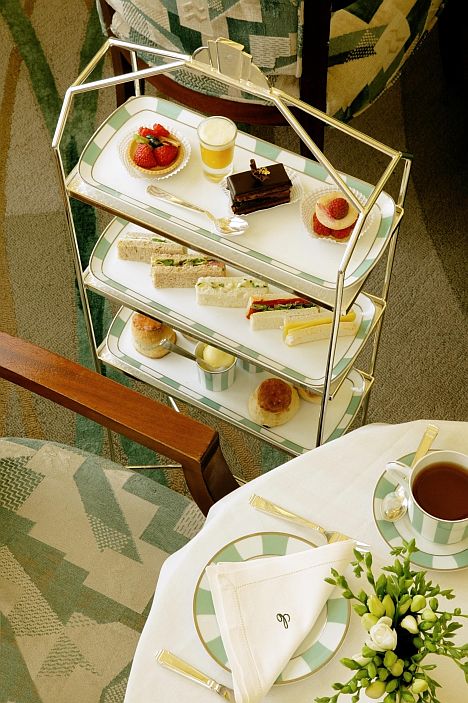
A three-tier stand at Claridge’s. Photo © Claridge’s.
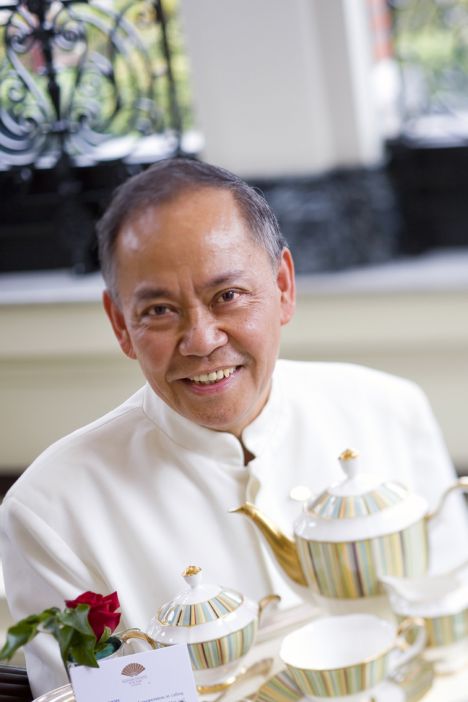
The Afternoon Tea at the Mandarin Oriental Hyde Park. Photo © Mandarin Oriental.

Afternoon tea in the lounge at The Milestone. Photo © The Milestone Hotel and Apartments, London.

Three-tier stand. Photos © Brown’s Hotel, London / Rocco Forte Hotels.

High Tea at the Palm Court. Photos © The Ritz London.
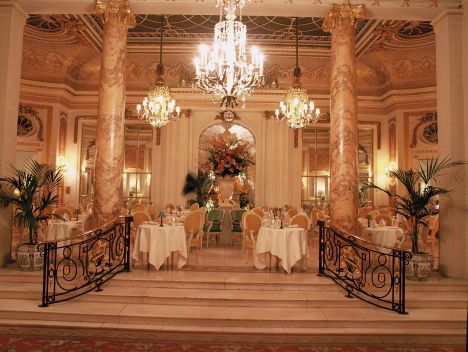
The Palm Court, where the afternoon tea is served. Photo © The Ritz London.

The Park Restaurant at the Mandarin Oriental Hyde Park, where the Afternoon Tea is served, with the Royal Horse Guards in the background riding through Hyde Park. Photo Copyright © Mandarin Oriental.

Afternoon tea at Claridge’s. Photo © Claridge’s.
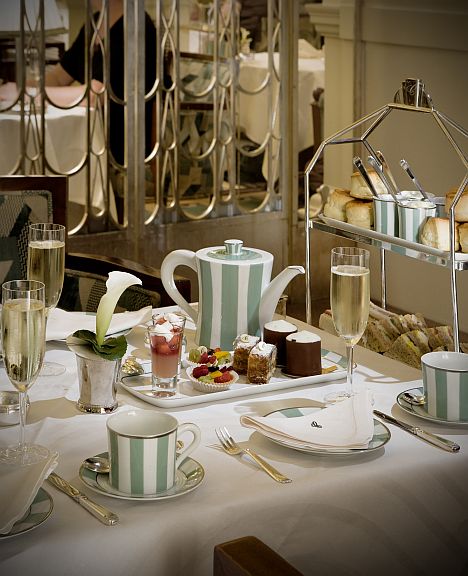
Afternoon tea at Claridge’s. Photo © Claridge’s.
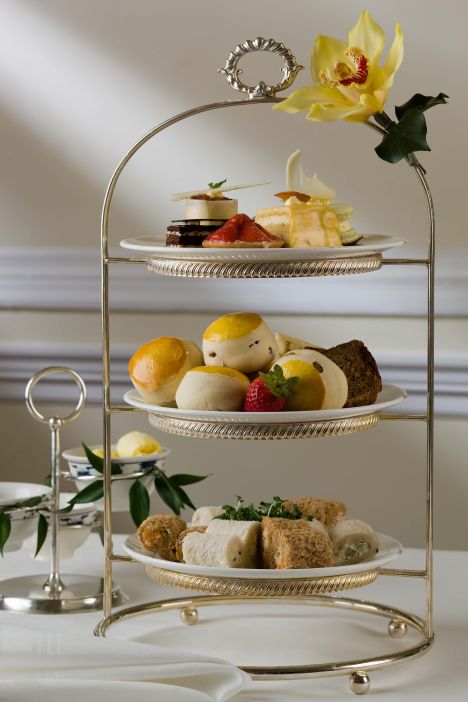
The Afternoon Tea at the Mandarin Oriental Hyde Park. Photo © Mandarin Oriental.

AA Britain’s Best: Afternoon Tea. 2004, 192 p. The book contains a short history of “The Tradition of Tea”, pages 16-17, which was used for the historical part of this article. The main part of the book, some 140 pages, is dedicated to short descriptions of the best places for tea in England, Scotland and Wales. Get it from Amazon.co.uk or Amazon.de.
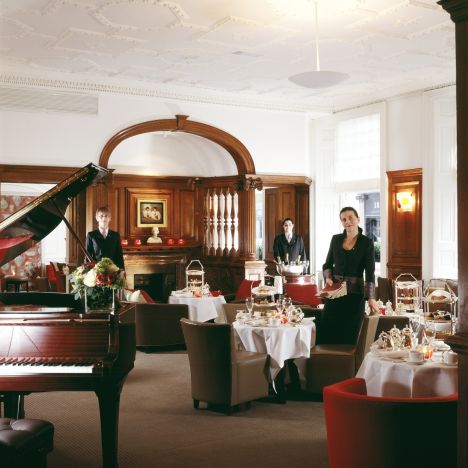
Afternoon Tea at Brown’s Hotel. Photo © Brown’s Hotel, Rocco Forte Hotels.